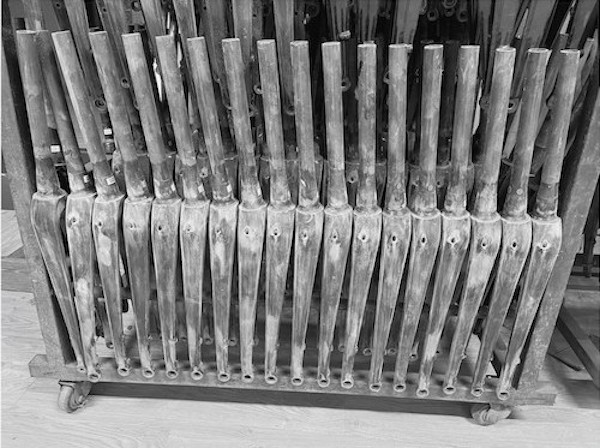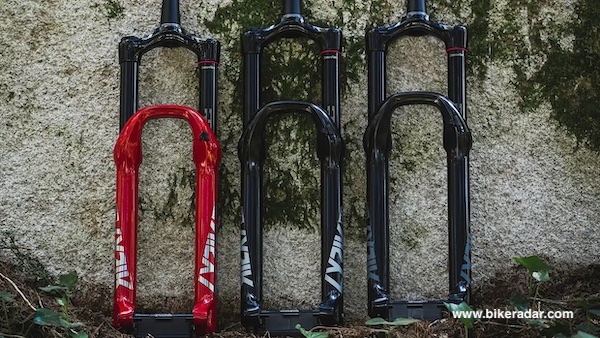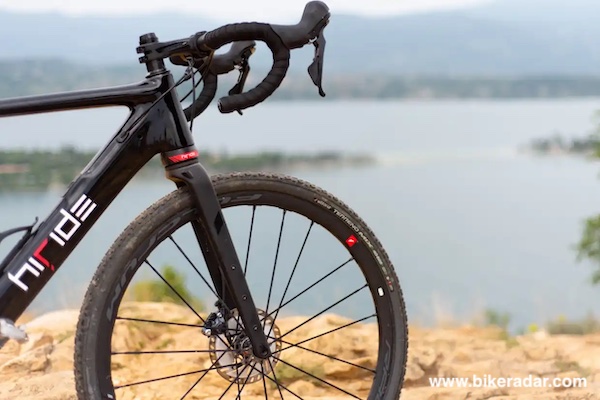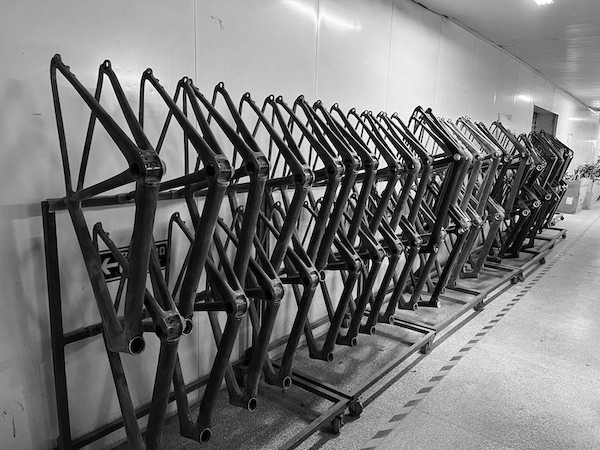Categories
New Blog
Tags

As we all known,two of the most popular fork materials are carbon fiber and aluminum. When we plan to choose a bike fork, we are not sure which one is best on your bike.Actually,the fork material depends on the type of riding you do, where you ride, and your personal preference. This guide will list the differences between carbon fork and aluminum fork.
In this guide, we’ll compare weight, compliance, durability, cost, ride quality, handling, and much more. We’ll also discuss the best fork material for different types of bikes and styles of riding. Whether you ride a mountain bike, road bike, touring bike, or gravel bike, hopefully, this guide helps you choose the ideal fork.
Carbon Fiber Forks
Carbon fiber is a lightweight composite material that is used to build high-end and high-performance bicycle forks. It is made of strong fibers that are woven together into sheets and then bound with epoxy resin.
In the 1970s, carbon fiber frames were introduced. Over time, they have increased in popularity in the bicycle industry. These days, most competitive cyclists use a carbon frame and fork.To make a bike fork, carbon fiber is layered into a mold shaped like a fork and then heated. Carbon fiber can be used to make the fork arms, fork crown, and steerer tube.
A number of techniques can be used to build carbon forks and fine-tune their performance and ride characteristics. For example, manufacturers can vary the weave of the carbon fibers, the type of resin, the thickness of the layers, the direction of the fibers, the density of fibers, the way the carbon is heated and molded, etc.
Aluminum Forks
Pure aluminum is too soft for building bike forks. Aluminum is alloyed with other elements such as silicon, magnesium, or zinc to increase strength and durability. The two most common aluminum alloys used for building bike forks are called 6061 and 7005.
Aluminum forks can be hydroformed. This process uses high-pressure hydraulic fluid to shape the fork. The arms can also be butted to reduce weight. Aluminum forks are welded together.
Carbon Vs Aluminum Fork: Differences and Pros and Cons
Carbon and aluminum can both be used to build lightweight, responsive, and durable forks for a wide range of bikes. Below are mainly their differences and the main advantages and disadvantages of carbon vs aluminum forks.
Compliance/Stiffness
Compliance refers to the flex of the fork arms when the bike hits an obstacle, such as a pothole or bump in the road. The amount that your fork flexes depends partially on the material it’s made of.Ideally, the fork should have torsional rigidity and some vertical compliance.
Carbon forks are more compliant than aluminum forks. With a carbon fork, you’ll feel less road buzz. Carbon fiber also does an excellent job of absorbing vibrations due to its low density. Modern carbon forks are designed to have some vertical flex. This helps to smooth out bumps.
At the same time, carbon forks don’t flex excessively. The material is fairly rigid. This makes cornering precise and predictable. For these reasons, most competitive cyclists choose carbon forks. Carbon is the go to material for performance.
Aluminum forks are much more rigid than carbon. They don’t flex enough to absorb bumps or road buzz. Bumps and vibrations are transmitted through the rigid fork and into the handlebars. This makes the ride feel harsh. Particularly while riding on rough gravel roads. You’ll feel every bump more. During long rides, vibrations can cause your hands, wrists, and shoulders to fatigue.
The extra fork stiffness does make the bike handle predictably and responsively. Particularly while riding at high speeds. This is important if you require precision.
Early carbon forks were overly rigid. Modern models offer much more compliance. Manufacturers use thinner and more flexible carbon fork arms to improve compliance.
The fork design also plays a role in stiffness. For example, forks that are designed for disc brakes are stiffer than those designed for rim brakes. The fork arms need to be strong enough to resist torsional forces caused by the disc brakes. Because the caliper is located on the side of the fork, the fork wants to twist during heavy braking. Stiff forks prevent this twisting. Some compliance is sacrificed to achieve sufficient stiffness. If you want a more compliant fork, go with v brakes or cantilever brakes.

Carbon Vs Aluminum Fork Weight
Carbon fiber forks are lighter than aluminum forks.Because it has a much lower density than aluminum. It also has a higher strength-to-weight ratio. The lighter weight is the biggest advantage of carbon forks. It’s the reason almost all competitive cyclists use them.
One of the main advantages of a lighter bicycle is acceleration. A lighter bike can accelerate faster than a heavier bike. You can spin up to speed more quickly when starting from a stop. Additionally, a lighter bike is more efficient, as it requires less energy to maintain speed. This can be especially helpful when climbing hills. You won’t get as tired as quickly. All of these factors combine to make a lighter bike generally faster. A lighter carbon fiber fork can be an excellent choice for cyclists who are looking to improve their performance.
The weight difference between carbon and aluminum forks is insignificant for a casual cyclist. You might notice that the acceleration is slightly quicker. For a competitive cyclist, the weight advantage is crucial. If you’re looking to cut weight, carbon fiber is the best choice.
Carbon Vs Aluminum Fork Durability and Resilience
Aluminum forks are more durable than carbon fiber. They can handle harder impact forces without sustaining damage. They are also resilient against abrasion. A scratch on an aluminum fork is usually just cosmetic. Aluminum forks can handle lots of use and abuse without failing. They can really take a beating.
Carbon forks can’t handle a hard impact without failing. If you crash your bike, there is a good chance the carbon fork will crack. This is because carbon fiber is a much more brittle material than aluminum. It’s relatively easy to damage a carbon fork during an accident. Carbon fiber doesn’t bend like metal, it cracks. Even a small chip or scratch on a carbon fork can compromise the fork’s structural integrity.
The superior durability makes aluminum forks a great choice for those who ride in cycling disciplines where accidents are common, such as many forms of mountain biking. A more durable fork allows you to attempt more challenging trails without worrying about damaging your bike if you crash. Commuters and those who ride long through remote regions, such as bicycle tourists and bikepackers, can also benefit from the durability. Aluminum forks are less likely to leave you stranded.
Fork Safety
Aluminum forks can be safer to ride than carbon fiber. This is because aluminum is less likely to suddenly fail. In most cases, the fork will give you some early warning signs when it reaches the end of its life. Carbon fiber may not give you the same warning.
Carbon and aluminum forks fail in different ways. Aluminum forks may crack first, then slowly fail over time. A cracked or bent aluminum fork will noticeably change the geometry and handling of the bike. You might hear some creaking in the fork. The steering may feel different. If you notice any of these issues, you know that your fork is not safe to ride.
Oftentimes, it’s not immediately obvious when a carbon fork is damaged or about to fail. You could easily miss a hairline crack during an inspection. Cracks can also form under the paint, where they are impossible to spot. Poor quality materials or manufacturing defects can also make a carbon fork unsafe to ride. If a carbon fork gets cracked or dented during an accident it is not safe to ride.
Inspecting a Fork For Damage
Regardless of the fork material, you should inspect it for damage after an accident and periodically throughout the riding season. Carbon forks require more frequent inspections because they are more likely to fail without warning. A small rock chip or some broken fibers could render a carbon fork unsafe to ride. It is also unsafe to ride cracked or dented aluminum forks because it is impossible to determine the structural integrity of damaged aluminum.
To inspect a carbon fork, start by running a cloth along the fork arms. Broken fibers catch on the cloth. This indicates damage to the carbon fibers. Next, look for scratches in the paint. If you spot damage, gently tap around the area with a coin. When you hear a change in pitch or if the tap sounds dull, there is probably carbon damage. If you spot a dent or chip, gently press around the area. If it feels soft, the carbon fiber is broken. Also, inspect the dropouts for wear or damage.
To inspect aluminum forks, look for any cracks or dents in the arms and dropouts. Carefully inspect all the welds to ensure there aren’t any cracks or crimping. Also, check to make sure that the wheels are aligned properly.
If you’re unsure, take the bike to a professional for a safety inspection.
Comfort and Ride Quality
Carbon fiber forks offer a more comfortable ride than aluminum. This is the case because carbon fiber offers more vertical flex. The fork isn’t completely rigid.
This flex allows the fork to absorb some bumps. Carbon fiber is also great at absorbing vibrations. As a result, your hands, wrists, and shoulders won’t fatigue as much while you ride. This is ideal for longer rides. You can ride further without tiring out.

At the same time, carbon forks don’t twist or flex excessively. They are vertically compliant but laterally stiff. This is possible thanks to modern manufacturing techniques. Manufacturers can fine-tune the fork by varying the thickness of the carbon fiber layers, the direction of the fibers, the type of resin, etc. Modern manufacturing techniques such as 3D modeling can printing can also be used to optimize the ride quality. This allows for a wide range of options in terms of ride quality from very stiff to quite compliant. Manufacturers can strike an excellent compromise between fork compliance and rigidity.
Aluminum forks, on the other hand, are extremely stiff. This stiffness allows more bumps and road buzz to transmit from the road into your hands. This makes the ride feel harsh and uncomfortable while riding on a rough road surface. For this reason, aluminum forks aren’t ideal for gravel cycling or bikepacking.
Aerodynamics
Carbon fiber and aluminum forks can both be molded into aerodynamic shapes. The fork arms can be shaped into narrow blades or teardrop shapes that cut through the wind. This reduces wind resistance, improving efficiency.
Carbon fiber can be molded into thinner blades than aluminum without sacrificing too much strength or rigidity. This is possible because carbon fiber is a far stronger material than aluminum. The fork arms can be thinner while still maintaining sufficient strength. Aluminum fork arms have to be a bit wider. They cause a bit more drag, as a result. The difference is minimal.
Aerodynamics really only matters if you ride at high speeds. Once you reach speeds above around 15 miles per hour, wind resistance becomes the biggest force acting against you. Having an aerodynamic advantage really only matters for competitive cyclists. Casual cyclists probably won’t notice a difference.
Carbon Vs Aluminum Fork Price
For many cyclists, the decision between a steel and carbon fork comes down to your budget. Carbon forks are more expensive than aluminum forks. The price difference can be significant.
Carbon forks are more expensive because the material is much harder to work with. Most of the work must be done by hand by skilled craftsmen. More hours of labor are required to build each fork. Working with carbon fiber also requires expensive molds and specialized equipment. The raw material is fairly expensive too. This all adds to the cost of production.
Aluminum forks are far cheaper for several reasons. First, the material is easier to work with. Much of the manufacturing process can be automated. Less human labor is required. Aluminum forks can be easily mass-produced in factories. The raw material is also cheaper. Most entry-level bicycles come with aluminum forks for these reasons. They’re cheap.
If you’re on a tight budget and you’re looking for the best performance-to-cost ratio, aluminum is the way to go. If you go with aluminum, you’ll get a lightweight and durable fork at an affordable price. Those with a higher budget may be better off with carbon fiber.
Fork Longevity- Fatigue, Corrosion, and Degradation
Aluminum fatigues over time. It does not have a fatigue limit. Every time force is applied to an aluminum fork, it fatigues slightly. Over time, this adds up until the fork fails. An aluminum fork usually cracks when it fails.
Carbon fiber also does not have a fatigue limit, like aluminum. The difference is that carbon fiber is much more resistant to fatigue. Carbon fiber tends to fail in a different way. They fatigue throughout the entire structure. They don’t fail at a single point. When a carbon fork reaches the end of its life, it will start to crack, delaminate, debond, or individual fibers will break.
Corrosion isn’t an issue with carbon fiber or aluminum. Carbon fiber doesn’t corrode because it’s not a metal.
Aluminum corrodes and creates aluminum oxide. Aluminum corrosion remains on the surface of the metal. It doesn’t corrode away over time, like steel. You don’t really have to worry about corrosion on an aluminum bike.
Aluminum and carbon forks are both long-lasting materials. You can get decades of use out of either if you don’t expose them to a hard impact. In the real world, aluminum forks will usually outlast carbon forks. People regularly ride aluminum bicycles that are 20-30 years old. Carbon forks often fail prematurely during a crash. It is uncommon to see a carbon bike that is older than 15 or so years. If you treat your carbon fork gently and don’t crash, it will probably outlast an aluminum fork.
Carbon Vs Aluminum Fork Handling
Carbon forks offer better handling than aluminum. This is because carbon fiber can be made incredibly stiff laterally. It doesn’t twist while taking a hard corner. The ride is more responsive and predictable. At the same time, carbon fiber has enough vertical flex to absorb some bumps and vibrations.
Aluminum also offers responsive and predictable handling due to its rigidity. The problem is that aluminum is almost too rigid. The ride feels harsh and unforgiving. This can make the bike a bit harder to handle while riding at high speeds on a rough road surface.
Efficiency
Carbon forks offer greater efficiency than aluminum forks. This allows you to travel further and faster using less energy. This is the reason that pretty much all professional cyclists prefer carbon forks over aluminum.
Carbon forks are more efficient for three main reasons. First, they are lighter by up to 300 grams. It takes less energy to accelerate, climb, and maintain your speed when you ride a lighter bike because you don’t have to move as much mass around while you ride. You burn less energy when you carry less weight.
Next, carbon fiber forks are rigid like aluminum forks. When you corner or brake, the fork doesn’t flex torsionally. Torsional rigidity increases efficiency. When the fork flexes, some energy is wasted flexing the fork instead of moving you forward. A rigid fork allows you to transfer your energy from the pedals to the wheels efficiently. Carbon forks also have some vertical compliance. This allows you to ride faster over a rough road surface because the fork can absorb some impacts.
Finally, carbon forks can offer better aerodynamics. Manufacturers can mold the fork arms into more narrow blades. Aluminum fork arms have to be a bit thicker. The narrow fork arms create less drag. You don’t have to burn as much energy overcoming wind resistance.
Individually, each of these efficiency gains is minimal. When you add them all together, you will notice carbon fork has a slight increase in efficiency than aluminum forks.
Fork Options
If you go with a carbon fork, you’ll have far more options to choose from. These days, carbon fiber is the standard for mid-range high-end road bikes. Whatever type of fork you want, you can find it in carbon fiber.
Aluminum forks are a bit less common. They are less popular than carbon or steel forks. You’ll have fewer options to choose from if you go with an aluminum fork.
Aluminum Frame With Carbon Fork
An aluminum frame with a carbon fork is a great combination for those looking for a lightweight and comfortable bike. The aluminum frame will be durable and relatively lightweight. The carbon fork can improve comfort by absorbing some shocks and vibrations. Carbon is much more compliant than aluminum. Installing a carbon fork can also save around 150-300 grams over an aluminum fork. This is a great way to cut some weight. A bike with a carbon fork and aluminum frame will also be significantly cheaper than a full carbon bike. It’s a great compromise for those on a budget.
There are some drawbacks to consider. The carbon fork will make the bike slightly less durable. You’ll have to inspect the fork more often for safety.

Carbon Frame With Aluminum Fork
You can install aluminum forks on carbon fiber frames. For most riders, it doesn’t really make sense. Aluminum forks will make the ride feel a bit harsher. The material doesn’t do as good of a job of absorbing bumps. Aluminum forks will also make the bike a few hundred grams heavier.
There are some benefits. If your carbon fork breaks, you could save a bit of money by installing an aluminum model. Aluminum forks also make the bike a bit more durable. Another potential benefit of using an aluminum fork is that it could improve safety. If you’re afraid of catastrophic fork failure, you might consider installing an aluminum fork on your carbon frame.
Do Carbon Forks Crack Easily?
No, carbon forks don’t crack easily. Modern models are incredibly strong and durable. Carbon forks usually only crack during an accident. If you accidentally drop your bike or if your bike tips over, your carbon fork won’t be damaged. Under normal riding conditions, it is uncommon for carbon forks to crack.
If you crash your bike head-on with a carbon fork, the fork is more likely to crack than a metal fork. This is not because carbon is a weak material, but rather because it is more brittle than other materials. Metals are much less brittle. Carbon forks are not quite as forgiving as metal forks. They are still strong and durable. They do not crack easily.
Who Should Choose Carbon Fork?
Carbon forks are significantly lighter than their aluminum counterparts. If you’re looking to save weight, a carbon fork is a great option.
Those who regularly ride a rough road surface are also better off going with a carbon fork due to the compliance that they offer. A carbon fork can provide a smoother and more comfortable ride.
Carbon fiber is also the go-to material for competitive cyclists who are looking to gain an edge on the competition. If you’re willing to invest in a fork that will help you ride faster and more comfortably, then a carbon fiber fork is worth considering.
Carbon fiber forks are often seen as a high-end option. If you want to ride the best equipment available, you should go with a carbon fork.
Who Should Choose an Aluminum Fork?
For casual cyclists or those on a budget, an aluminum bike fork is a great choice. Aluminum is less expensive than other materials used for bike forks. It’s a budget-friendly option.
In addition, aluminum is known for being a safe and durable material. You don’t have to worry as much about your fork breaking or causing an accident. This makes aluminum forks a great choice for those who are hard on their bikes.
Through the above elaboration, it will be more clear to choose a carbon fiber or aluminum bike fork. If you prioritize compliance, weight, comfort, efficiency, and aerodynamics, then carbon is the way to go. But if price, durability, and longevity are more important to you, stick with aluminum. Whichever material you choose, I hope this guide helps you choose the best fork for your style of riding.